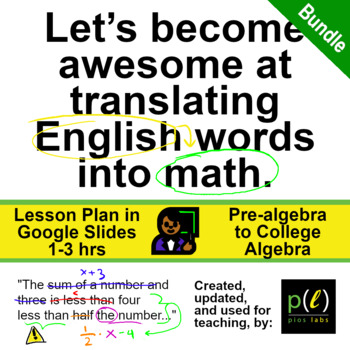Translate Words to Math - Lesson, Handouts, Slides, Teacher Notes, & Activities
Pios Labs
43 Followers
Grade Levels
6th - 12th, Higher Education, Adult Education, Homeschool, Staff
Subjects
Resource Type
Standards
CCSS6.NS.C.5
CCSS6.NS.C.7b
CCSS6.EE.A.2
CCSS6.EE.A.2a
CCSS6.EE.A.2b
Formats Included
- Google Slides™
- Easel Activity
Pios Labs
43 Followers

Includes Google Apps™
This bundle contains one or more resources with Google apps (e.g. docs, slides, etc.).
Easel Activities Included
Some resources in this bundle include ready-to-use interactive activities that students can complete on any device. Easel by TPT is free to use! Learn more.
Products in this Bundle (4)
Description
Teach how to translate English words into math, according to this lesson plan and associated slides or handouts, in a 1 hour to 3 hour lesson.
This bundle includes:
- Fully editable Google Slides document
- PDF of slides for student handouts
- PDF of teacher notes to guide teaching
- Printable cutouts activity for matching English to math
Use this lesson to:
- Lead students through at least 56 problems and 7 group activities in math and literacy, either in person or online.
- Serve as a starting point to integrate into your own lessons. Customize or edit the file in Google Slides to make it more your own style.
- Review or enrich student reading skills, in translating English sentences, phrases, and words into mathematical statements.
- Review or introduce fundamental math concepts in algebra, like addition, subtraction, multiplication, division, geometry, fractions, decimals, percents, number properties, integers, variables, expressions, equations, and inequalities.
- Have students speak and discuss their ideas in active learning activities, both in groups and individually.
- Have students write mathematical statements and ideas.
- Integrate literacy, language, science, and creativity into math.
Target Level of Math Class:
- Pre-algebra to College Algebra.
- Meant earlier in the course, before doing in-depth problem-solving in algebra or geometry.
- Differentiated for a wide range of student backgrounds and abilities. Choose to include or exclude problems involving fractions, decimals, percents, or variables as needed. Focus more on literacy as needed, or for ELL/ESL.
- Previously used and developed with K-12 (high-school level) students and adult students (GED, HiSET, TASC, TSI, etc) in mind.
- Larger default font sizes ideal for group work or lower-vision students, if printed.
Options for How to Use This File:
- Print slides as handouts for a physical, in-person class.
- Print or refer to this file with presentation notes included, when leading your own lessons online about translating English to math.
- Present Google Slides document in your own LMS or online platform, such as Blackboard Collaborate, Google Meet, or Zoom. Ideally you could write on top of this presentation with various software -- contact Pius at Pios Labs for suggestions for your system.
- Solutions are included for all exercises so students/teachers can check them right away as formative assessments.
Total Pages
Answer Key
Included
Teaching Duration
2 hours
Last updated Sep 28th, 2021
Report this resource to TPT
Reported resources will be reviewed by our team. Report this resource to let us know if this resource violates TPT’s content guidelines.
Standards
to see state-specific standards (only available in the US).
CCSS6.NS.C.5
Understand that positive and negative numbers are used together to describe quantities having opposite directions or values (e.g., temperature above/below zero, elevation above/below sea level, credits/debits, positive/negative electric charge); use positive and negative numbers to represent quantities in real-world contexts, explaining the meaning of 0 in each situation.
CCSS6.NS.C.7b
Write, interpret, and explain statements of order for rational numbers in real-world contexts. For example, write -3° 𝐶 > -7° 𝐶 to express the fact that -3° 𝐶 is warmer than -7° 𝐶.
CCSS6.EE.A.2
Write, read, and evaluate expressions in which letters stand for numbers.
CCSS6.EE.A.2a
Write expressions that record operations with numbers and with letters standing for numbers. For example, express the calculation “Subtract 𝘺 from 5” as 5 - 𝘺.
CCSS6.EE.A.2b
Identify parts of an expression using mathematical terms (sum, term, product, factor, quotient, coefficient); view one or more parts of an expression as a single entity. For example, describe the expression 2 (8 + 7) as a product of two factors; view (8 + 7) as both a single entity and a sum of two terms.





